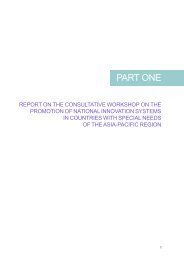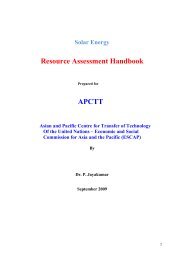energy technologies, which can enable the use of fossil energy resources, in particularcoal, for electricity generation in a manner that is compatible with climate changemitigation. In this context, a major challenge is to find ways to attract investmentsneeded for the deployment of advanced FFTs so that the shift to a low-carbon economycan be achieved through the transition to a more efficient electricity sector.In his valedictory address, Mr. R.V. Shahi, former Secretary, Ministry of Power,Government of India, emphasised that renewables cannot be the only solution forIndia’s growing power sector needs. The megawatt installed capacity of conventionalsources and of renewable sources differ in terms of the energy supply. Mostly, therenewable sources supply about 25 per cent of the energy for same megawatt installedcapacity.Coal will continue to be the major resource for electricity generation in India. Unfortunately,the quality of coal in India is very poor and its availability too is an issue. The countryneeds to find solutions to these problems.The heat rate for sub-critical and supercritical power plants differ but they also varywith the loading conditions of the power plant, and the advantage gained in supercriticalmay not be very pronounced in India’s operational conditions. Even when supercriticaltechnology is used, almost 60 per cent of the energy is being wasted. The challengefor the technologists is to find solutions for using the total energy content of coal.There are three key issues in India’s power sector development: we do not have thetechnology; we do not know to use the technology; and we are not allowed to use thetechnology. Looking to the West for technology will not bring a solution; instead majorcompanies like CIL, BHEL and NTPC should jointly take up the challenge and findsolutions.India has been criticised for slippages in installation of electricity generation capacity.It should be noted that despite the coal production remaining stagnant and fuel linkagesnot established, India could still add over 54,000 MW during the 11 th FYP.R&D funds have been created from cess on coal production and import. There isDeforestation Funds of Rs 150 billion (US$2.95 billion) and Transmission ConstraintFund of Rs 12 billion (US$235.90 million) raised for developing climate-friendlytechnologies. However, the utilization of these funds has still not been structured.Therefore, there is an urgent need for creating a policy framework to put all these fundsat one place and utilize them appropriately.While financing is always a challenge, it will never be a constraint in the growth ofIndia’s power sector if the country is able to fix technological, administrative and socialissues associated with this sector.Mr. Shahi said the current Workshop has given greater insight into the power sectorissues that need to be addressed and hoped that the baseline study being conductedby APCTT-ESCAP would effectively bring together all the issues involved.28
IVCONCLUSIONSAfter discussions on the advances in FFTs and the investment requirements for powergeneration in India, the experts at the Workshop reached the following major conclusions:• Coal will remain the primary source for power generation in several countriesincluding India. Low-carbon technologies and carbon capture and storage wouldbe the key enabling technologies to address carbon emissions from the continueduse of fossil fuels. Coal mining, washing and transportation need to be in focus.• Technological advancements on coal combustion have made impressive stridesand reflect the possibility of high-efficiency supercritical, ultra-supercritical andadvanced supercritical power plants to be in operation in India based on localmanufacturing capabilities.• Large capacities for local manufacturing of power plants have been created byBHEL, Larsen & Toubro/Mitsubishi, BGR Energy Systems/Hitachi, JSW Energy/Toshiba, Bharat Forge/Alstom, and Thermax/Babcock and Wilcox. These capacitieswere created in India based on the government’s projected targets. On the otherhand, the customs duty concessions for equipment for large power plants and thehigher excise duty in India have adversely affected local manufacturing capacities.• R&D in the power sector is being promoted. The government has created a specialfund by putting a carbon tax on total coal supply from India and abroad, whichstood at Rs 65 billion (US$1.28 billion) on 31 March 2012. However, the lack ofproper policy for the utilization of the funds has hampered their appropriatedeployment for low-carbon technologies. Besides establishing a policy framework,the government also needs to create a separate authority for the utilization ofthese funds. Promotion of venture capital funds that take equity risk could contributeto successful commercialization of innovations.• Investment mobilization should be feasible. An economy growing at a rapid rateshould have little difficulty in mobilizing the needed resources, particularly throughPPP. The main challenge appears to be to create efficient and financially viableenergy sub-sectors so that the investors have the incentive to invest in a competitiveenvironment where the interests of both investors and consumers are protected.• Investment in the power generation sector is an opportunity for business to grow.The Expert Committee on Integrated Energy Policy in India, in its report of 2006,projected that the electricity generation, transmission and distribution sector alonewill require an investment of more than US$1 trillion. The Working Group on Powerfor the 12 th FYP has projected an investment requirement of more than Rs 13trillion (US$256 billion), with more than 28 per cent only for the coal-based powergeneration capacity creation.• The private sector is expected to meet 50 per cent of the targets for the 12 th FYP.That is, an investment of almost US$130 billion is expected from the private sector,including both domestic and foreign companies. This total investment could alsocome through the FDI route.• The Working Group on Power also studied various options for equity, debt,multilateral/bilateral funding and external commercial borrowing, and observed thatthere is likely to be an equity shortfall of Rs 903 billion (US$17.8 billion) and debtshortfall of Rs 974 billion (US$19.2 billion). Thus, an anticipated shortfall of Rs1,877 billion (US$37 billion) has been projected, which is an opportunity for foreigninstitutions and direct investors to be a part of the growth of India’s power sector.29
- Page 1 and 2: ADVANCES IN FOSSIL FUELTECHNOLOGIES
- Page 3 and 4: ADVANCES IN FOSSIL FUELTECHNOLOGIES
- Page 5 and 6: CONTENTSABBREVIATIONSiiiPART ONEREP
- Page 7 and 8: ABBREVIATIONSAC : Alternating curre
- Page 9: OECD : Organization for Economic Co
- Page 12 and 13: IORGANIZATION OF THE WORKSHOPA. Bac
- Page 14 and 15: D. Election of officersThe followin
- Page 16 and 17: IIICONSIDERATION OF ISSUESA. Backgr
- Page 18 and 19: emissions. Underground coal gasific
- Page 20 and 21: 800 MWe, a steam pressure of 300 kg
- Page 22 and 23: • Materials development & manufac
- Page 24 and 25: Figure 1-5: Strategy for commercial
- Page 26 and 27: tonnes, the state-owned enterprise
- Page 28 and 29: • Ensuring not just easy FDI entr
- Page 30 and 31: MW ultra-supercritical units; and s
- Page 32 and 33: the captive generation capacity) on
- Page 34 and 35: and other financial institutions -
- Page 36 and 37: and higher efficiency power generat
- Page 40 and 41: • Such massive financial inputs c
- Page 43 and 44: BASELINE REPORT ON FOSSIL FUEL TECH
- Page 45 and 46: B. General R&D climate in the count
- Page 47 and 48: a convenient way to envisage energy
- Page 49 and 50: to mature and become more cost-comp
- Page 51 and 52: emissions, at least relative to sin
- Page 53 and 54: The Ministry of Power (MoP), which
- Page 55 and 56: 3. Bio-energyBio-energy, widely ava
- Page 57 and 58: in such a canal will rotate at a lo
- Page 59 and 60: in tackling climate change. A one p
- Page 61 and 62: Advantages of supercritical plants
- Page 63 and 64: existing power plants but also to b
- Page 65 and 66: BASELINE REPORT ON FOREIGN DIRECT I
- Page 67 and 68: CEA at 598 mt. This is mainly due t
- Page 69 and 70: For India to maintain its momentum
- Page 71 and 72: Table 2-5: Electricity generation t
- Page 73 and 74: Growth, which submitted its interim
- Page 75 and 76: 3. Future challengesThe future chal
- Page 77 and 78: development worked out. Public-priv
- Page 79 and 80: Linking FDI to technology transferI
- Page 81 and 82: The total requirement of fund durin
- Page 83 and 84: Funding from multilateral agenciesM
- Page 85 and 86: cooperation will be essential in so
- Page 87: Planning Commission, Government of
- Page 90 and 91:
ANNEX I:LIST OF PARTICIPANTSMr. A.K
- Page 92 and 93:
Mr. S.C. Shrivastava, Joint Chief (
- Page 94 and 95:
ANNEX II:PROGRAMME6 June 2012, Wedn
- Page 96 and 97:
ANNEX III:AN OVERVIEW OF ADVANCED F
- Page 98 and 99:
• Technology solutions are also v
- Page 100 and 101:
Table 3-5: Improvement in cycle eff
- Page 102 and 103:
• No liquid effluent formation;
- Page 104 and 105:
Figure 3-5: Advancement of gas turb
- Page 106 and 107:
Figure 3-8: Goal 2 - New clean tech
- Page 108 and 109:
Compared with conventional power pl
- Page 110 and 111:
Figure 3-14: Thermax coal gasificat
- Page 112 and 113:
ANNEX VII:GE ENERGY AND ADVANCED FO
- Page 114 and 115:
ANNEX VIII:SWOT ANALYSIS OF FOSSIL
- Page 116 and 117:
By 2035, cumulative CO 2emissions f
- Page 118 and 119:
• Falling prices of renewable ene
- Page 120 and 121:
Figure 3-20: New advanced coal powe
- Page 122 and 123:
ANNEX X:ENERGY CONSERVATION: ERDA
- Page 124 and 125:
Table 3-11: Energy cost and intensi
- Page 126 and 127:
300Figure 3-23: Trends in coal use
- Page 128 and 129:
C. Gaps in coal use efficiencyFigur
- Page 130 and 131:
ANNEX XII:FINANCING OF THE POWER SE
- Page 132 and 133:
With the entry of many private sect
- Page 134 and 135:
for future requirements should be t
- Page 136 and 137:
Short supply of coal has started af
- Page 138:
Figure 3-35: Life-cycle of technolo







